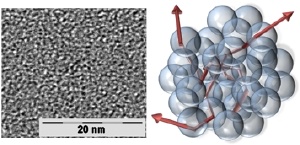"Light scattering" and "optical performance" are two concepts that usually head in opposite directions, but they have recently been shown to walk happily hand-in-hand. The results are impressive laser output from some new composite materials and the potential for making commercially viable solid-state dye lasers.

In an article in Advanced Materials, Dr. Inmaculada Garcia-Moreno and her colleagues at the Instituto de Quimica-Fisica "Rocasolano" and the Instituto de Ciencia y Tecnología de Polímeros in Madrid have shown that certain nanoparticles added to dye lasers can scatter light in a way that increases the efficiency of the material's laser action as well as make the materials easier to handle.
Lasers made from dyes can be tuned over a very broad visible wavelength, from the near ultraviolet to the infrared. They can be pulsed at high energy and are used for applications ranging from isotope separation and pollution monitoring to cancer therapies and tattoo removal. As the dyes used are liquids it is often helpful if they can be incorporated into a solid material. Organic polymer materials are usually used for this purpose, and inorganic particles are often added to improve the physical stability and handling properties. Unfortunately, the inorganic additives usually have detrimental effects on the optical properties of the composites, such as transparency and laser capabilities.
However, as the Spanish researchers have demonstrated, if the inorganic material comprises particles that are both small enough and randomly enough distributed, then the transparency of the composites is not affected and the emission from the dye is actually enhanced.
The chemistry that has made this possible is the use of nanoparticles of polyhedral oligomeric silsesquioxane (POSS) for the inorganic component. POSS is a silicon and oxygen-based material that can be readily incorporated into an organic matrix. The nanoparticles were found to be dispersed on a molecular level. The physics behind the laser enhancement is a phenomenon known as "incoherent random laser", in which the coherent light emitted by the dye is scattered weakly by the POSS nanoparticles, causing it to have an elongated path inside the material and providing extra feedback.
The researchers initially found it difficult to realize that a homogeneous material with nanoparticles in the range 0.5-4 nm could sustain scattering, but were able to show that not only did it occur, but that the effect was independent of the type of dye molecules used and their photophysics. "Thus," Dr. Garcia-Moreno claims, "dye-doped POSS solutions could be defined as a kind of universal gain media, overcoming the dye/host specificity that has been recognized as one of the greatest limitations of these laser systems."
Other advantages include "the easy synthesis of the POSS-based hybrid materials" and "their significantly improved physical, thermal, and optical properties as compared with the materials used up to now for incorporating lasing dyes". The researchers therefore see the possibility of using these new hybrid materials as alternative sources for optoelectronic devices, competing with dendronized or grafted polymers. "The POSS-based materials show the potential to bring to life a practical, commercial, easy-to-handle, and stable solid-state dye laser."